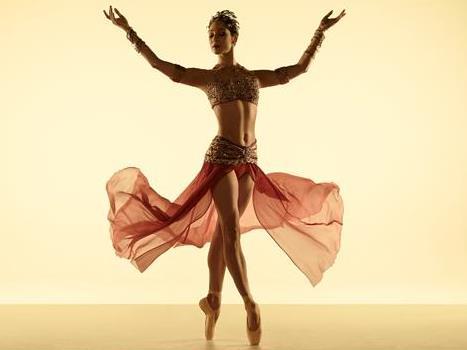Image source: australianballet.com.au
The Australian Ballet’s hype about its current major production urges audiences to ‘fall in love with the spectacular world of La Bayadere.’ Spectacular it is, beyond question, promising an ‘epic story of forbidden passion’ in which ‘a beautiful temple dancer and a heroic warrior fight for their love against a backdrop inspired by 19th-century visions of the exotic East’.
Wanting a little more detail of the plot I turned to David L. Groover’s synopsis just before curtain-up and found more than 1000 words, beginning with this: ‘Land of four-faced Lord Brahma, god of creations, and four-armed Kali, fearsome goddess of destruction … Land of the ferocious man-eating Bengal tiger and the delicate exquisitely coloured krait, the tiny serpent whose bite is lethal. Land of the mystic fakir, the magician with his rope trick. Land of the temple dancer, the bayadère, pledged for life to dance only for the gods.’
Although there was no time to read the detail I got the picture. La Bayadère was to be one of those overblown French or Russian ballets that delivered the contemporary 19th century view of the ‘exotic’. It had an impressive pedigree, however, with choreography by the French Marius Petipa to the music of Russian Ludwig Minkus, and first performed by the Imperial Ballet in St. Petersburg in 1877.
This version was choreographed by Stanton Welch who, rightly, was guided by the music, and introduced some particularly charming elements. There was more than a touch of Bollywood, noticeable in the costumes by Peter Farmer, who also did the workable set design. (Costumes and sets were courtesy of Houston Ballet).
Opening night saw Lana Jones in the lead role of Nikiya, the temple-dancer of the title, and Adam Bull as her dance partner, in the role of the warrior Solor. These trusted Principals of the Australian Ballet had the important task of making the dancing soar above the rather cluttered set and plot – and this they did. Jones has a grace that translates into every role she is given, at times being simply lovely to watch. Bull is notable for his strength, height and amazing ease with lifts, and did not disappoint.
There were two leading ladies (the other being Robyn Hendricks as Gazmatti, the Rajah’s daughter), putting the eternal triangle at the heart of this ballet. But while all three dancers were superb their interaction lacked heart, with Bull giving the same attention to both. Herein lay the problem with La Bayadère as compared with, say, Swan Lake, with its delineation of the difference between the White and Black Swan, and the tenderness shown by the Prince to Odette. If the dancers cannot be blamed, nor can the choreographer, as Minkus’s music does not seem to allow for such distinctions.
Even more startling, however, was our hero’s drug-induced dream of the Kingdom of the Shades in hope of seeing his lost love. Again, this was not a new concept for the ballet. But, unlike the wraiths of Act ll of Giselle, these women were in frothy short tutus and enjoyed a long sequence of apparently joyful, energetic dances. For the most part, the corps was coordinated and the dancers in step with each other; it’s just that the scene seemed to fit awkwardly into a ballet of eastern temples and palaces, dense gardens and intrigue.
In contrast the men who played guards, groomsmen and other roles had more interesting choreography than in more traditional ballets, where partnering and lifts can be the order of the day. On centre stage, they had the more fluid movements more often given to ballerinas – but with no loss of masculinity.
In a ballet crowded with characters it is virtually impossible to single out dancers from a fine array of soloists, although Brett Chynoweth was an agile and arresting God of Fire. Guest conductor Philip Ellis and Orchestra Victoria literally played an important part, sympathetic to the needs of the dancers, with concertmaster Yi Wang’s violin solos evocative and beautiful.
To conclude, I need again to quote the Australian Ballet’s pride in this production. ‘A kaleidoscope of beauty, colour and spell-binding movement, La Bayadère will leave you in awe. Don’t miss this spectacular night out at the ballet.’
Many ballet-goers expect colour, music and sensation from their visits to the ballet. They could not possibly have been disappointed.
Rating: 4 out of 5 starsLa Bayadère
Choreographer Stanton Welch
Music Ludwig Minkus
arranged by John Lanchbery
Costume and set design Peter Farmer
Lighting design Francis Croese
Melbourne: with Orchestra Victoria
Sydney: with Australian Opera and Ballet Orchestra
State Theatre
www.artscentremelbourne.com.au
28 August – 6 September





